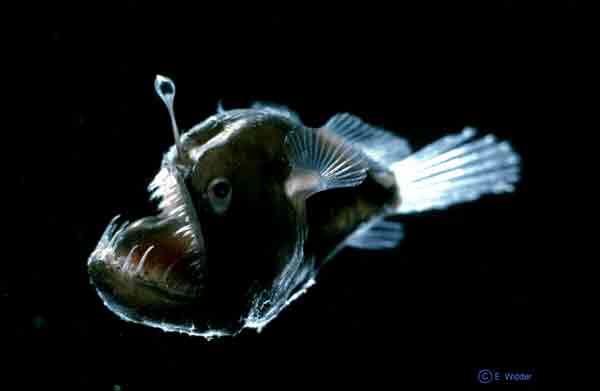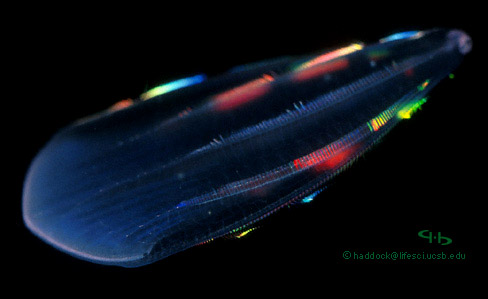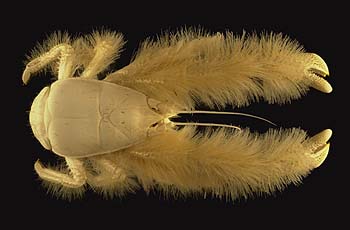According to Discovery Channel’s epic documentary, Blue Planet, Seas of Life, "Over 60% of our planet is covered by water more than a mile deep. The deep sea is the largest habitat on earth and is largely unexplored. More people have traveled into space than have traveled to the deep ocean realm."
Our imaginations of the deep ocean verge on the alien, and as more information is uncovered, and more species discovered, we are shocked into amazement that the planet that we know so intimately, can support such alien life.
The deep ocean, including the benthic and abyssal zones makes up more than 80% of the ocean biome. These areas are cold and dark, being far below the reach of sunlight. Life is not as frequent as there are no plants or algae to feed on, and animals who call these regions home must find other means to live.
The deep ocean has markedly different physical characteristics from other parts of the Earth and even other parts of the ocean. Different pressures, temperatures, salinity, oxygen and other factors cause animals to adapt to these environments, developing unique tools of predation, diversion, and reproduction.
Light is one of the biggest factors that influence the direction of development in the deep ocean. There is no sunlight that reaches the waters of the deep ocean, and so this “twilight zone” is only lit by bioluminescent animals, which produce light using chemicals within their own bodies. Most animals need additional senses besides sight to navigate the deep ocean and survive either by catching prey or avoiding predators. Bioluminescent animals can use their light to attract prey, deflect predators, and communicate with other members of their species. This production of light can be the difference between being eaten, and escape, and also for securing your lunch.
One such predator is the deep sea angler fish. This predator uses a number of methods for effective survival in the deep ocean. Instead of wasting energy in vain pursuit of food, it sits and waits, preferring to lure and ambush its prey. Its lure is an elongated dorsal fin equipped with bioluminescent photophores at the tip of the fin. The small glowing portion of the fin draws in smaller fish in search of food, and then the fish is ambushed when within striking range of the angler’s teeth. The angler fish’s teeth are long, sharp and curved inward, to ensure no escape from prey. This fish more closely resembles a horror film than it does represent Mother Nature.

This image shows a deep sea angler fish, which uses its adaptation, an elongated dorsal fin with photophores in the tip, to attract and ambush prey. Photo credit: US Santa Barbara Life Sciences
Ctenophores, commonly called Sea Gooseberries or Comb Jellies have a distinct pattern of eight rows (comb rows) of cilia, used for locomotion. The ciliated plates diffract light and cause a rainbow pattern of light to flash on the comb plates. Despite their mesmerizing beauty, the light attracts small prey which the Jellies consume whole.

Additionally many deep sea fish have large eyes, which help capture any residual light. This is the case with the strange Micropinna microstoma, which has tubular eyes shielded by a transparent head. The mechanism for the tubular eyes was recently discovered by researchers Bruce Robinson and Kim Reisenbichler, who found that the eyes can rotate within the transparent shield. The eyes can face upward when the fish is searching for food, and forward while feeding. Macropinna is one example of the development of the “barrel eye” whose tubular shape is ultrasensitive to capturing any remaining sunlight in the water. The transparent head, allows the eyes, while facing upward, to search for shadow, throwing prey.

Light is not the only factor affecting life in the deep ocean, however. Pressure is another important influence. The pressure underwater increases 1 atmosphere for every 10 meters of depth. Pressures in the deep ocean can reach 1,000 atm. This makes studying the deep ocean difficult, since observation is limited and collected samples have to be pressurized to maintain stability. Animals in the deep ocean have adapted to the higher pressures through bodies without excess cavities that could collapse under intense pressure. Additionally, bones and flesh material are more gelatinous and soft which helps to withstand increased pressure. As a result, there are more jellyfish-like animals, worms and soft crustaceans than bony fish residing in the deep ocean.
One most amazing mollusc is the famed giant squid. Legends of the giant squid have been around since ancients have taken to the sea, and tales of a giant creature wraps its tentacles around ships and drags vessel and crew to the ocean depths. Although unlikely that any such creature is the cause of a sailor’s watery grave, tales of the giant squid do have some merit. Specimens of the giant squid have been well documented, and samples collected around the world. But an even more amazing creature exists: the colossal squid. That’s right, there is a squid that is bigger than giant. The Colossal squid, Mesonychoteuthis hamiltonia, lives in estimated depths of 2,000-2,200 meters. In 2007, a live colossal squid was brought to the surface near New Zealand, and was measured to be 10 meters long and weighed over 1,000 pounds. This half-ton behemoth is the largest invertebrate ever captured. Scientists identified it as a male of the species, and speculate that females could be even larger. Unlike giant squid, the colossal squid have swiveling hooks on each of the sucker disks at the ends of the feeding tentacles. These tools help this colossal predator wrangle with prey, and escape predators, most notably the Antarctic sperm whale.

Food sources are rare in the deep ocean, as the lack of sunlight and oxygen prevent algae and other plants to inhabit the depths. Life, however, seems to find new sustenance nearer hydrothermal vents. Dives near the Galapagos at depths of 2,700 km led to the discovery of a new ecosystem where life is sustained by the hot, mineral rich water which erupts from geysers in the seafloor. Heated by magma, the vents are found in or near mid-ocean ridges where new sea floor is formed. Metal sulfides are expelled along with other nutrients and communities of worms, and other animals thrive in the sunless environment. Most animals have special bacteria that turn hydrogen sulfide into food.
One such creature discovered near a hydrothermal vent is the Yeti Crab. This deep sea crab is blind, and is covered in long yellow hairs, or setae, which give the crab its name. This mythical crab was discovered near Easter Island, in the vents along the Pacific-Antarctic ridge by the research submarine Alvin. In an attempt to explain how creatures colonize the hydrothermal vents, specimens of the crab was collected and revealed that the crab’s hairy limbs support large colonies of bacteria. This supports scientist’s speculations that the crab in fact, farms the bacteria which live on the hydrogen sulfide possibly as a source of food. The hairs may also act as chemical and physical sensors to help find food or mates.

This image of the Yeti crab shows the long hairs that cover the limbs of the animal. Scientists think that the hairs support large colonies of sulfide consuming bacteria which the crab possibly uses for food. Photo credit: (c) 2005 Ifremer / A. Fifis
References:
The Monterey Bay Aquarium Research Institute:
Researchers solve mystery of deep-sea fish with tubular eyes and transparent head
Discovery of the "Yeti Crab"





Comments